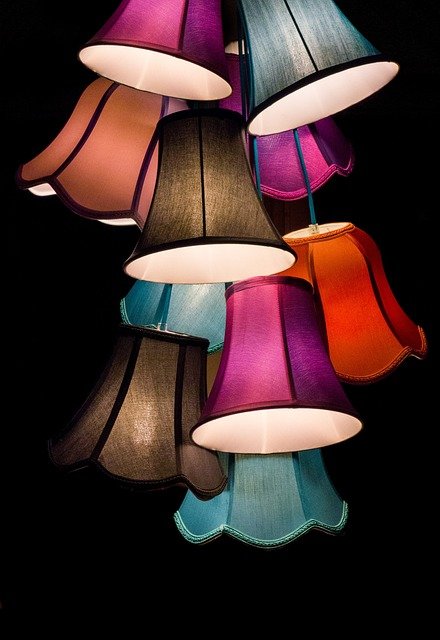Illuminating Spaces: The Art of Sculptural Lighting
In the ever-evolving world of interior design, a new trend is casting a mesmerizing glow on our living spaces. Sculptural lighting, a fusion of illumination and artistry, is transforming homes into captivating galleries of light and shadow. This innovative approach to lighting design goes beyond mere functionality, elevating lamps and fixtures to the status of statement pieces that command attention even when unlit.

The Genesis of Light as Art
The concept of sculptural lighting isn’t entirely new, but its recent surge in popularity marks a significant shift in how we perceive and utilize light in our homes. Tracing its roots back to the mid-20th century, we find pioneers like Isamu Noguchi, whose paper lanterns blurred the lines between sculpture and lamp. These early explorations laid the groundwork for today’s bold, boundary-pushing designs.
As technology advanced and materials evolved, designers found new ways to play with light and form. The advent of LED technology, in particular, opened up a world of possibilities, allowing for sleeker, more diverse shapes and sizes that were previously impractical with traditional bulbs.
The Intersection of Form and Function
What sets sculptural lighting apart is its dual nature. These pieces are not just sources of illumination; they are works of art in their own right. During the day, they serve as eye-catching sculptures, adding visual interest and depth to a space. As night falls, they transform, casting light in innovative ways that can dramatically alter the mood and perception of a room.
This duality challenges the traditional notion of lighting as a purely utilitarian element. Instead, sculptural lighting invites us to consider light fixtures as integral parts of our interior design, capable of making bold statements and evoking emotional responses.
Materials and Techniques: Crafting Light
The world of sculptural lighting is vast and varied, with designers pushing the boundaries of what’s possible. Materials range from the traditional – glass, metal, and wood – to the unexpected, such as recycled plastics, paper, or even living plants.
Glass remains a favorite medium, prized for its ability to refract and diffuse light in beautiful ways. Artisans are experimenting with techniques like slumping, fusing, and blowing to create organic forms that seem to defy gravity. Metal, too, is being reimagined, with intricate laser-cut patterns and polished surfaces that play with reflection and shadow.
3D printing has emerged as a game-changer in this field, allowing for complex geometries and customizations that were previously impossible or prohibitively expensive. This technology has democratized sculptural lighting, making unique, bespoke pieces more accessible to a wider audience.
The Psychology of Light and Space
The impact of sculptural lighting goes beyond aesthetics. Light plays a crucial role in how we perceive and interact with our environment, affecting everything from our mood to our circadian rhythms. Sculptural lighting designs often incorporate this understanding, creating pieces that not only look stunning but also contribute to our well-being.
For instance, some designs mimic natural light patterns, helping to maintain healthy sleep-wake cycles. Others use color-changing capabilities to influence mood, allowing users to adjust the ambiance of a space to suit different activities or times of day.
The placement of sculptural lighting can also dramatically alter the perception of a space. A large, statement piece can become a focal point, drawing the eye and anchoring a room. Conversely, a series of smaller, delicate fixtures can create a sense of movement and flow, guiding the viewer through the space.
Integrating Sculptural Lighting into Your Home
While the allure of sculptural lighting is undeniable, incorporating these pieces into existing décor can be challenging. The key is to strike a balance between the lighting as art and the overall design of the space.
In minimalist interiors, a bold sculptural piece can serve as a captivating centerpiece, adding warmth and personality to an otherwise austere environment. In more eclectic spaces, the key is to choose pieces that complement rather than compete with existing elements.
Scale is another important consideration. A large, dramatic fixture can make a statement in a spacious living room or entryway, while smaller, more delicate pieces might be better suited to intimate spaces like bedrooms or reading nooks.
The Future of Illumination
As we look to the future, the world of sculptural lighting continues to evolve. Emerging technologies like OLED (Organic Light Emitting Diode) panels promise even more flexibility in design, allowing for paper-thin, bendable light sources that could revolutionize the field once again.
Sustainability is also becoming a key focus, with designers exploring eco-friendly materials and energy-efficient technologies. Some are even experimenting with bioluminescent organisms, creating living light sculptures that blur the line between nature and design.
The rise of smart home technology is also influencing sculptural lighting, with many pieces now incorporating features like voice control, motion sensors, and the ability to sync with music or television for immersive experiences.
As our homes continue to serve multiple functions – from living spaces to offices to retreats – the role of lighting becomes increasingly important. Sculptural lighting offers a way to meet our practical needs while also satisfying our craving for beauty and inspiration in our daily lives.
In conclusion, sculptural lighting represents a exciting convergence of art, design, and technology. It challenges us to rethink the role of light in our homes and offers endless possibilities for creativity and personal expression. As this trend continues to evolve, it promises to keep our living spaces illuminated in the most captivating ways imaginable.





